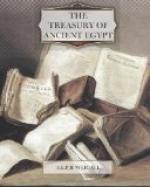In 1907 the condition of the monuments of Lower Nubia was very bad. The temples already mentioned were in a most deplorable state; the cemeteries were being robbed, and there was no proper organisation for the protection of the ancient sites. There are, moreover, several temples above the level of high water, and these were also in a sad condition. Gerf Husen was both dirty and dilapidated; Wady Sabua was deeply buried in sand; Amada was falling to pieces; Derr was the receptacle for the refuse of the town; and even Abu Simbel itself was in a dangerous state. In my report I gave a gloomy picture indeed of the plight of the monuments. But now all this is changed. Sir Gaston Maspero made several personal visits to the country; every temple was set in order; many new watchmen were appointed; and to-day this territory may be said to be the “show” portion of this inspectorate. Now, it must be admitted that the happy change is due solely to the attention to which the country was subjected by reason of its flooding; and it is not the less true because it is paradoxical that the proposed submersion of certain temples has saved all the Lower Nubian monuments from rapid destruction at the hands of robbers, ignorant natives, and barbarous European visitors. What has been lost in Philae has been gained a thousand-fold in the repairing and safeguarding of the temples, and in the scientific excavation of the cemeteries farther to the south.
Here, then, is the sober fact of the matter. Are the English and Egyptian officials such vandals who have voted over a hundred thousand pounds for the safeguarding of the monuments of Lower Nubia? What country in the whole world has spent such vast sums of money upon the preservation of the relics of the Past as has Egypt during the last five-and-twenty years? The Government has treated the question throughout in a fair and generous manner; and those who rail at the officials will do well to consider seriously the remarks which I have dared to make upon the subject of temperate criticism.
CHAPTER XII.
ARCHAEOLOGY IN THE OPEN.
In this chapter I propose to state the case in favour of the archaeologist who works abroad in the field, in contrast to him who studies at home in the museum, in the hope that others will follow the example of that scholar to whom this volume is dedicated, who does both.
I have said in a previous chapter that the archaeologist is generally considered to be a kind of rag-and-bone man: one who, sitting all his life in a dusty room, shuns the touch of the wind and takes no pleasure in the vanities under the sun. Actually, this is not so very often a true description of him. The ease with which long journeys are now undertaken, the immunity from insult or peril which the traveller now enjoys, have made it possible for the archaeologist to seek his information at its source in almost all the countries of the world; and he is not obliged, as was his grandfather, to take it at second-hand from the volumes of mediaeval scholars. Moreover, the necessary collections of books of reference are now to be found in very diverse places; and thus it comes about that there are plenty of archaeologists who are able to leave their own museums and studies for limited periods.




